List of chicken breeds
There are hundreds of
The physical traits used to distinguish chicken breeds are size,

In the 21st century, chickens are frequently bred according to predetermined
| Table of contents |
|---|
|
By place of origin: Afghanistan • Albania • Australia • Austria • Belgium • Brazil • Bulgaria • Canada • Chile • China • Croatia • Cuba • Czech Republic • Egypt • Finland • France • Germany • Greece • Iceland • India • Indonesia • Iran • Italy • Japan • Korea • Kosovo • Malaysia • Myanmar • Netherlands • Norway • Pakistan • Philippines • Poland • Portugal • Romania • Russia • Serbia • Slovakia • Slovenia • South Africa • Spain • Sweden • Switzerland • Thailand • Turkey • Ukraine • United Kingdom • United States • Vietnam |
|
By primary use: Eggs • Meat • Dual-purpose • Exhibition |
By place of origin
Afghanistan
Albania
Australia
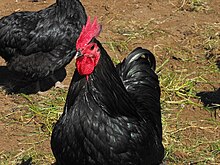
|
Austria
Belgium
|
|
Brazil
|
Bulgaria
|
Canada
Chile
China

|
|
Croatia

Cuba

Cyprus
Czech Republic
|
|
|
Egypt
Finland
France
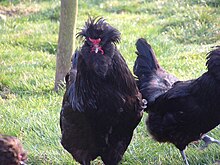
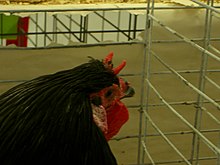

- Aquitaine[17]
- Ardeale[4]
- Ardennaise,
or Sans-queue des Ardennes[17] - Barbezieux[17]
- Blanzac[4]
- Bourbonnaise[17]
- Bourbourg[17]
- Bresse Gauloise[17]
- Caumont[17]
- Caussade[17]
- Charollaise[17]
- Cocherelle[4]
- Combattant du Nord[17]
- Contres[17]
- Cotentine[17]
- Coucou des Flandres[17]
- Coucou de France[17]
- Coucou de Rennes[17]
- Coucou Picarde[4]
- Coucou Soie[4]
- Cou-nu du Forez[17]
- Courtes-Pattes[17]
- Crèvecœur
- Estaires[17]
- Faverolles clair (light)[17]
- Faverolles foncée
(dark, or "German" Faverolles)[17] - Favoris[4]
- Gasconne[17]
- Gâtinaise[17]
- Gauloise dorée[17]
- Géline de Touraine[17]
- Gournay[17]
- Hergnies[17]
- Houdan[17]
- Ivanaise[4]
- Janzé[17]
- Javanaise[17]
- La Flèche
- Landaise[17]
- Le Mans[17]
- Le Merlerault[17]
- Meusienne[17]
- Limousine (coq de pêche)[17]
- Lyonnaise[17]
- Mantes[17]
- Marans[17]
- Noire du Berry[17]
- Noire de Challans[17]
- Pavilly[17]
- Poule d'Alsace[17]
- Poule de Caux[4]
- Poule de Marquise[4]
- Poule de Saint-Omer[4]
- Poule des Courrières[4]
- Poule des haies, see Ardennaise[4]
- Provençale[4]
Germany

(illustration by Jean Bungartz, 1885)

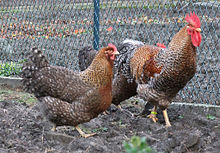
Large breeds
- Annaberger Haubenstrupphühner[18][19]
- Augsburger[18][19]
- Bergische Kräher,[18][19]
- Bielefelder Kennhuhn[18][19]
- Deutsches Lachshuhn,[18]
see Faverolles[19] - Deutsche Langschan,[18]
see German Langshan[19] - Deutsches Reichshuhn[18][19]
- Deutsche Sperber[18][19]
- Dresdner[18][19]
- Hamburger,[18]
see Hamburg[19] - Kraienköppe (Twents hoen)[19]
- Lakenfelder,Lakenvelder[19]
- Nackthalshühner, see Naked-neck[19]
- Niederrheiner[18][19]
- Ostfriesische Möwen,East Frisian Gull
- Pfälzer Kämpfer[19]
- Phoenix[19]
- Ramelsloher[18][19]
- Rheinländer[18][19]
- Sachsenhuhn[18][19]
- Strupphuhn, see Frizzle[19]
- Sultanhuhn, see Sultan[19]
- Sundheimer[18][19]
- Thüringer Barthuhn[18][19]
- Vogtländer[18][19]
- Vorwerkhuhn,[18]
seeVorwerk[19] - Westfälische Totleger,Westphalian chicken
Bantams
- Bergische Zwerg-Kräher[19][20]
- Bergische Zwerg-Schlotterkämme[19][20]
- Bielefelder Zwerg-Kennhühner[19][20]
- Brügger Zwerg-Kämpfer[20]
- Deutsche Zwerghühner[19][20]
- Deutsche Zwerg-Lachshühner,Faverolle Bantam[19]
- Deutsche Zwerg-Langschan,[20]
see German Langshan Bantam[19] - Deutsche Zwerg-Reichshühner[19][20]
- Deutsche Zwerg-Sperber[19][20]
- Frankfurter Zwerghühner[19][20]
- Ostfriesische Zwerg-Möwen[19][20]
- Ruhlaer Zwerg-Kaulhühner[19][20]
- Siamesisches Zwerg-Seidenhühner[19][20]
- Thüringer Zwerg-Barthühner[19][20]
- Zwerg-Altsteirer[19][20]
- Zwerg-Amrocks[19][20]
- Zwerg-Andalusier,Andalusian[19]
- Zwerg-Araucana,[20]
see Rumpless Araucana Bantam[19] - Zwerg-Asil,[19] see Asil Bantam
- Zwerg-Augsburger,[20]
see Augsburger Bantam[19] - Zwerg-Australorps,[20]
see Australorp Bantam[19] - Zwerg-Barnevelder,[20]
see Barnevelder Bantam[19] - Zwerg-Brahma,[20]
see Brahmas[19] - Zwerg-Brakel,[20]
see Brakel Bantam[19] - Zwerg-Créve Coeur,[20]
see Crevecoeur Bantam[19] - Zwerg-Dominikaner,[20]
see Dominique Bantam[19] - Zwerg-Dresdner[19][20]
- Zwerg-Hamburger, see Hamburg Bantam[19]
- Zwerg-Italiener,[20]
see Leghorn Bantam[19] - Zwerg-Kastilianer[19][20]
- Zwerg-Krüper[19][20]
- Zwerg-La Fléche,[20]
see La Fleche Bantam[19] - Zwerg-Lakenfelder,[20]
see Lakenfelder Bantam[19] - Zwerg-Minorka,[20]
see Minorca Bantam[19] - Zwerg-Nackthalshühner,Naked-neckbantam
- Zwerg-New Hampshire
see New Hampshire Bantam[19] - Zwerg-Niederrheiner[19][20]
- Zwerg-Orloff,[20]
see Orloff Bantam[19] - Zwerg-Orpinglon[20]
see Orpington Bantam[19] - Zwerg-Phönix,[20]
see Phoenix[19] - Zwerg-Plymouth Rocks,Plymouth Rock Bantam[19]
- Zwerg-Rheinländer[19][20]
- Zwerg-Rhodeländer[19][20]
- Zwerg-Sachsenhühner[19][20]
- Zwerg-Sulmtaler,[20]
see Sulmtaler Bantam[19] - Zwerg-Sundheimer[19][20]
- Zwerg-Sussex,[20]
see Sussex Bantam[19] - Zwerg-Vorwerkhühner[20]
see Vorwerk Bantam[19] - Zwerg-Welsumer[20]
see Welsumer Bantam[19] - Zwerg-Yokohama[20]
see Yokohama Bantam[19]
Greece
Iceland
India

Indonesia
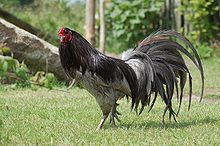
|
|
Iran
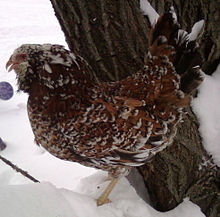
|
Italy

Japan
|
Korea
Kosovo
- Kosova Long-crowing[30](also called Tringjyrshet Kosov)
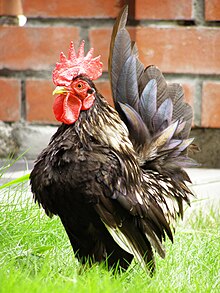
Malaysia
- Kampung
- Malay
- Serama
Mariana Islands
- Saipan Jungle Fowl
Myanmar
Netherlands

|
|
Norway
- Norwegian Jærhøne
Pakistan
Philippines
Poland
- Polbar[4]
- Zielononóżka Kuropatwiana (Green-legged Partridge)[4]
- Polish chicken
Portugal
Romania
- Transylvanian Naked-neck
Russia
|
Serbia
|
|
Slovakia
Slovenia
South Africa
Spain
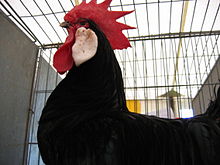

|
|
Sweden
|
Switzerland

Taiwan
Thailand
- Gai Chon[45]
- Gai Puen Muang[45]
- Pradu Hang Dum[45] or Pradu Hang Dam Chiangmai[46]
- Thai Game[47]
Turkey
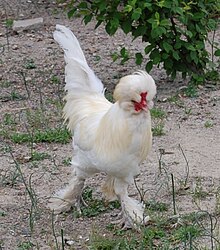
Ukraine
United Kingdom
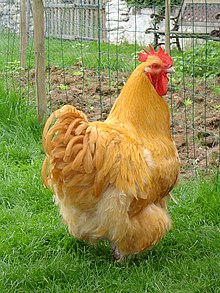
|
|
United States of America
|
|
Vietnam
By primary use
All chickens lay
Eggs
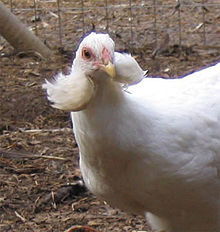
Many breeds were selected and are used primarily for producing
|
|
Meat
Most farms and homesteads use dual-purpose breeds for meat production. Some breeds are raised mainly for meat:
Dual-purpose
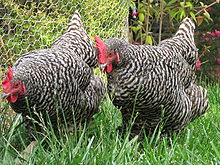
Plymouth Rock breed
The generalist breeds used in barnyards worldwide are adaptable utility birds good at producing both meat and eggs. Though some may be slightly better for one of these purposes, they are usually called dual-purpose breeds.
|
|
Exhibition
Since the 19th century,
| Key |
|---|
|
U denotes a breed primarily used for exhibition, but which is still used for utility purposes. |
|
G denotes a game breed. |
